Bolivia Travel Guide
When I think of Bolivia, I recall its rugged streets, average food, and the poorest internet connection I’ve ever experienced. However, it’s also a nation abundant in natural beauty and culture.
Often dubbed the Tibet of the Americas, Bolivia is regarded as one of the most isolated countries in the region because, like Paraguay, it’s landlocked. Compared to other countries in the Americas, Bolivia boasts the highest proportion of indigenous people, with approximately 60 percent of its population being of pure Native American ancestry.
This guide is primarily for those who want to plan a backpacking trip, but it will also be helpful for those who perhaps opt for a few extra comforts.
Quick menu
- When to visit Bolivia
- Documents and vaccinations to enter Bolivia
- What to do and see in Bolivia
- Suggested itineraries Bolivia
- How to get around Bolivia
- Backpacking Bolivia: costs
- Backpacking Bolivia: safety
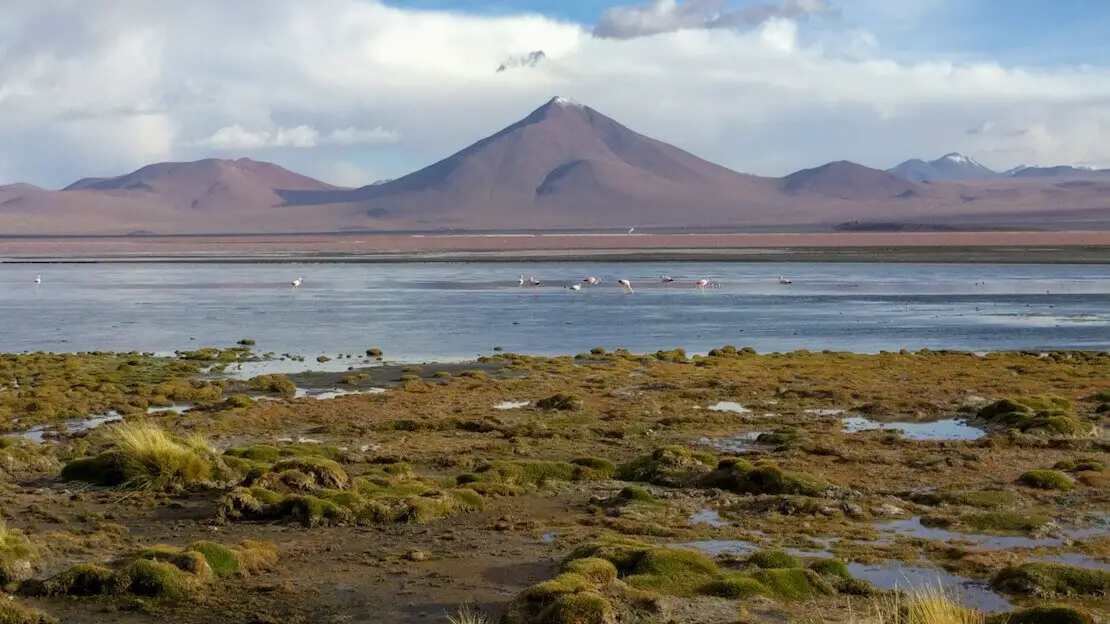
Laguna Colorada, Reserva Eduardo Abaroa.
When to visit Bolivia
Speaking generally, the climate varies radically according to altitude, but it is still possible to divide it into two seasons.
The dry season, which runs from May to October, is the best time to visit the country. In the highlands, especially at night, it can be cold, but the days are almost always sunny, making it the best time for trekking. At lower altitudes and in the Amazon rainforest, temperatures are lower than in the rainy season, but rainfall, although lower, is still present.
The rainy season, which runs from November to March, is much more pronounced at low altitudes and in the Amazon rainforest, where roads are often impassable, temperatures are high, humidity is high, and mosquitoes are abundant. In the highlands, it rains less, and temperatures are pleasant, but given the almost daily rainfall and the often cloud-covered peaks, it is not the best time for trekking.
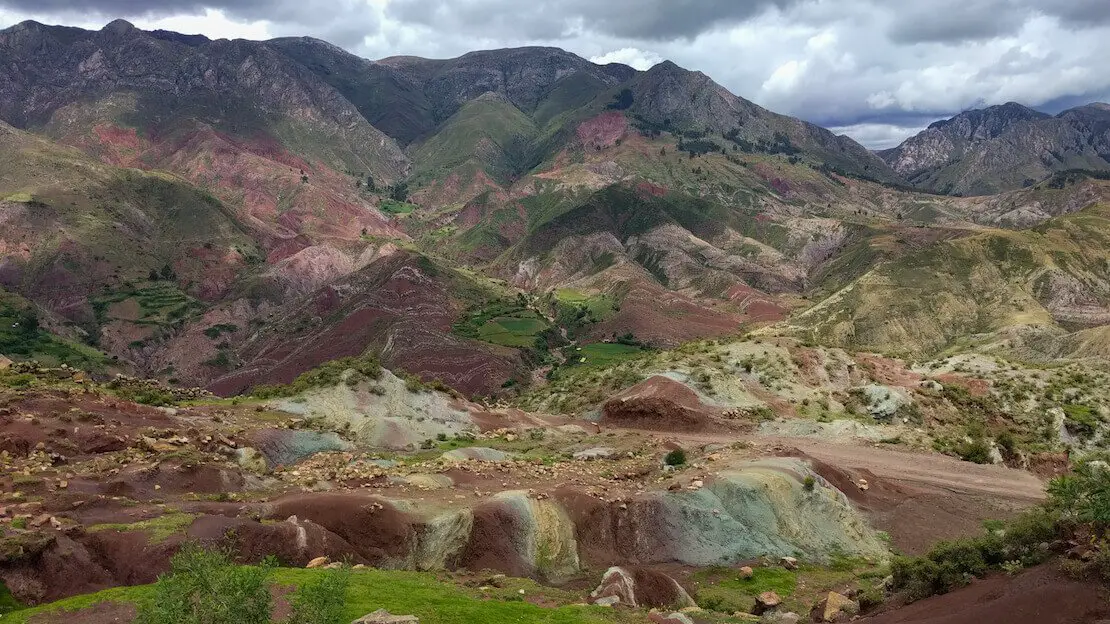
Maragua Crater Hike.
Documents and vaccinations to enter Bolivia
Most passport holders receive a 30-day tourist visa when they enter the country. The visa can be renewed free of charge for up to 90 days.
To renew your visa, you must go to an immigration office equipped with your passport and immigration green card (received when you enter the country). In La Paz, the office is located at 1433 Avenida Camacho. Here you can find a detailed guide.
If you exceed the duration of your visa, the moment you leave the country, you will have to pay a fine of 20 bolivianos for each extra day.
For more information, please visit the official website.
Bolivia does not require any mandatory vaccinations, but Hepatitis A, Hepatitis B, and yellow fever are recommended, especially if you decide to visit the Amazon rainforest.
CAUTION: If you are coming from or have recently been to Argentina, Brazil, Colombia, Ecuador, French Guiana, Panama, Paraguay, Peru, Trinidad and Tobago, Venezuela, or any African nation, yellow fever vaccination is mandatory. Often, no border control is done overland, but airlines tend to be more strict about it.
What to do and see in Bolivia
The Amazon rainforest almost entirely covers the northeast of the country. Most tourist attractions are concentrated in the south and east, in predominantly mountainous areas.
In this guide, prices are expressed in the local currency called “Boliviano,” often abbreviated as “Bs” or “BOB.” The exchange rate at the time of publication of this article is 1€ = 8 BOB. I suggest you look at this page to see the current exchange rate.
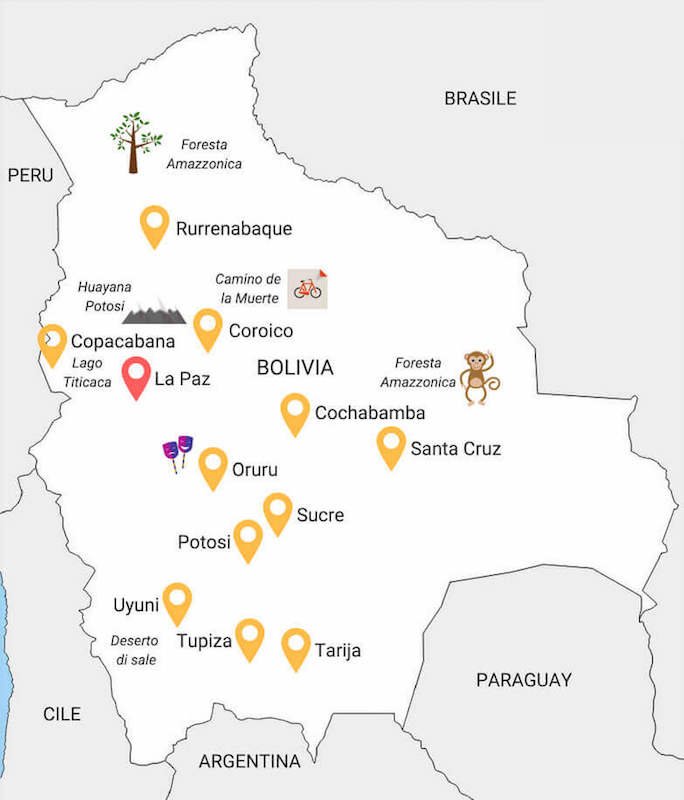
N.b. Several times throughout the guide, you will find links to https://www.alltrails.com/. Upgrade to the pro version if you want offline navigation directly from the Alltrails app. However, you can get around this by downloading the coordinates from the site’s desktop version in “Google Earth KML” format and then uploading them to organic maps, which is by far one of my favourite travel apps.
La Paz
At 4058 meters above sea level, La Paz is the highest capital city in the world, and if you are coming from sea level, you will definitely notice. The town is not spectacular and resembles a jungle of traffic and concrete at high altitude, but it is undoubtedly fascinating in some respects.
What to do and see in La Paz
Join the free walking tour
The tour is not free, as it is not allowed by law, but it costs only $3. Of all the ones I have participated in, it was definitely one of the most interesting. You will be told some really interesting stories about the city’s history, starting with the famous San Pedro Prison, a rather peculiar prison.
Take the cable car to El Alto.
Following the example of Medellin in Colombia, La Paz has created a cable car system that connects the city center to the poorer neighborhoods surrounding it. For travelers, it is a way to enjoy the most striking views. On a clear day, the top of Mount Illimani can be seen in the background.
There are two lines from which you have a good view:
- The red line runs from Estación Teleférico Central (Google Maps) to Estación 16 de Julio. Once you reach El Alto, exit the station to enjoy the view fully.
- The yellow line from Chuqui Apu/Libertador to Mirador/Qhana Pata also offers good city views.
The cable car system works like a subway. You pay 3 bolivianos each time you enter the system.
If you can visit El Alto on Thursdays or Sundays, take advantage of the market, which is among the largest in South America (Google Maps). You can find anything (take the red line). Beware of pickpockets.
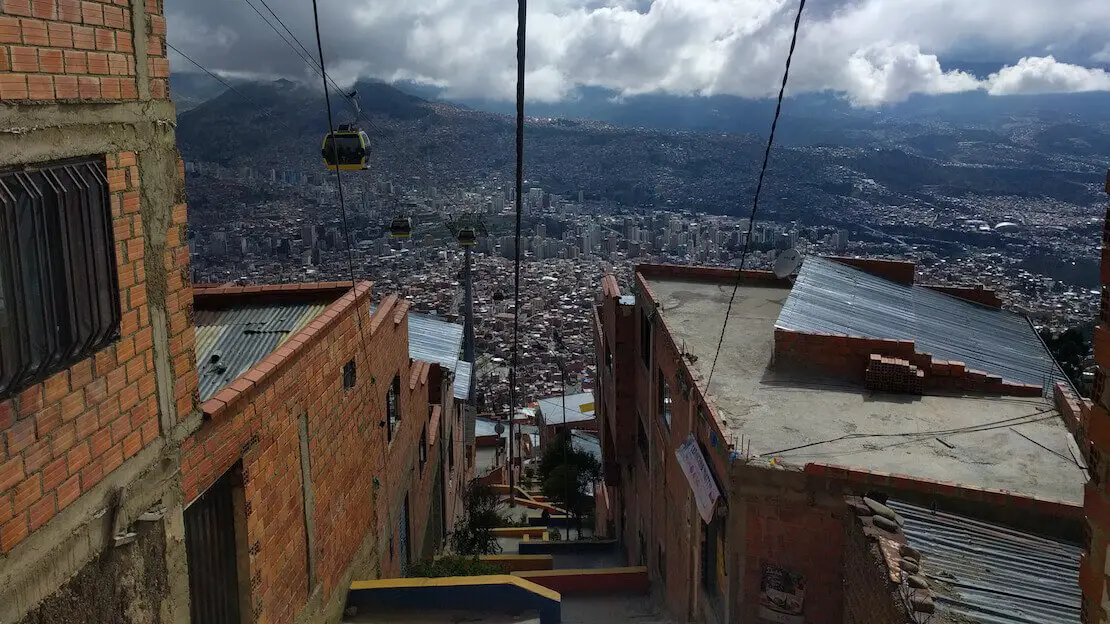
La Paz.
Cholita wrestling
Cholitas are indigenous Bolivian women known for their distinctive attire, which includes bowler hats atop their heads and wide, brightly colored skirts.
Every Thursday at 6:30 p.m. and Sunday at 4:30 p.m., these women put on a wrestling show that draws hundreds of spectators and has become a tourist attraction in La Paz over the years. Let’s be honest—it’s a truly bizarre event, but definitely worth experiencing while in La Paz!
Most agencies and hostels offer tours that include transportation, snacks, admission, and a small souvenir for around 85 Bolivianos. While you can arrange it on your own, keep in mind that agencies often secure the best seats, and touring El Alto at night is not recommended.
Valle de la Luna
The Valley of the Moon (Google Maps) is a unique rock formation about 10 km from La Paz. It is not a valley but miniature canyons and rocky peaks.
All agencies in La Paz offer visits, but getting there alone is easy and an excellent way to spend a half day.
How can you reach the Valle de la Luna from La Paz?
Take a direct collective to Mallasa from the stop near San Francisco Church and Calle Sagarnaga, costing around 3 to 4 Bolivianos and taking 30 to 40 minutes, or about 30 Bolivianos by cab. You will be dropped off at the entrance. To return, you’ll take one of the many collectivos heading to downtown La Paz.
The site is open from 8 a.m. to 5:30 p.m., and admission costs 15 Bolivianos.
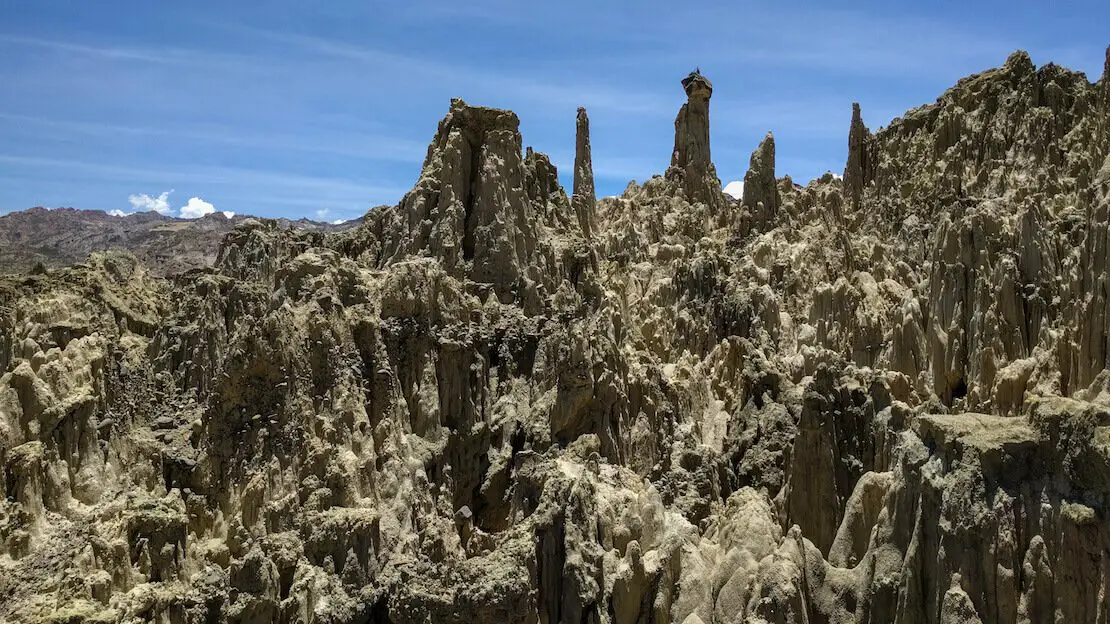
Valle de la Luna.
Camino de los Yungas or Camino de la Muerte (death road)
The Camino de la Muerte, or “Death Road,” near La Paz, earned its title as the most dangerous road in the world back in 1995. Stretching about 61 kilometers, it was the primary route to the capital for vehicles traveling along the La Paz-Coroico section. Each year, between two hundred and three hundred people lost their lives driving along it.
Fortunately, a new road has replaced the Camino de la Muerte entirely, turning it into a tourist attraction. Along the Camino de los Yungas, you can embark on a downhill biking adventure starting at 4650 meters amidst rather chilly temperatures and ending at 1200 meters, where you’ll encounter an almost tropical climate. The entire experience, coupled with the diverse landscapes, makes for a thrilling day out.
As for safety concerns, fear not; you’ll be equipped with protective gear and a helmet. The road sees minimal traffic, features guardrails at the most perilous sections, and allows you to proceed at your own pace without any rush. If, by any chance, you feel the need (though I doubt it), you can hop onto the bus that follows closely behind at any time.
The tour offered by all agencies in La Paz comes with a minimum price of 300 Bolivianos (I checked with at least ten different agencies), plus a 50 Bolivianos road maintenance fee. This fee covers transportation, equipment, snacks, and a buffet lunch, followed by a refreshing swim in the pool upon reaching the bottom. Overall, it’s an experience I recommend.
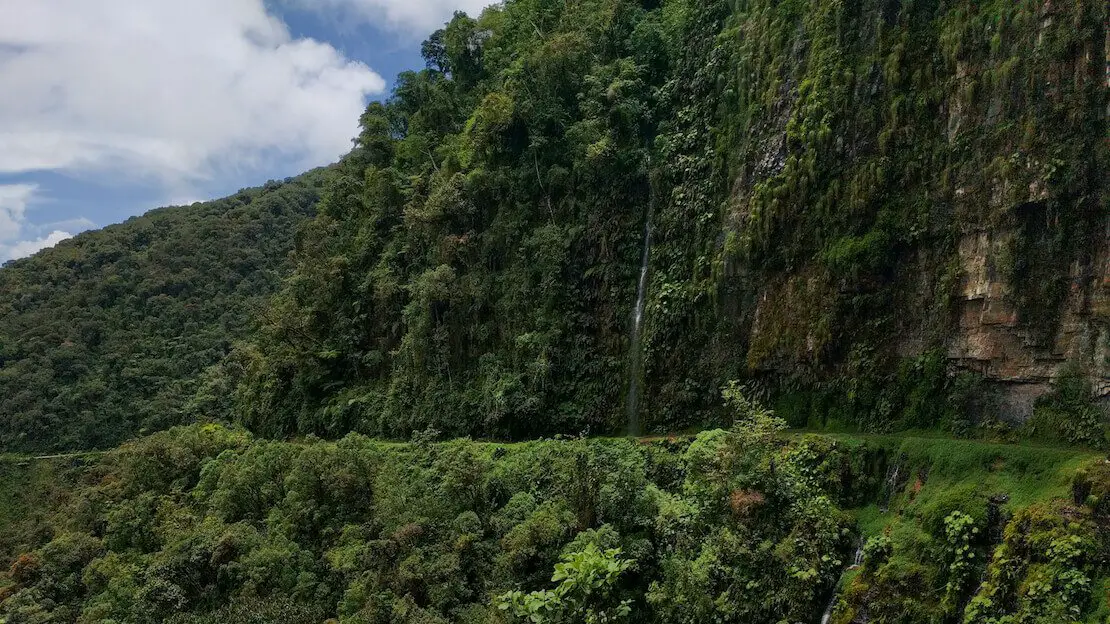
Camino de la Muerte (death road)
Trekking in and around La Paz
Finding an agency in La Paz that offers 2- or 3-day tours to climb Huayna Potosi is easy. It is considered one of the most accessible 6000-meter peaks in the world and is regularly climbed by thousands of more or less experienced mountaineers each year. Prices range from 900 to 1200 Bolivianos for the 3-day tour. I have not personally done it as I was in Bolivia during the rainy season, and the weather forecast for the days I was in La Paz was not favorable, but some friends decided to climb it. Although it is not a walk in the park, provided you are in decent shape and sufficiently acclimatized, it is definitely doable and undoubtedly unforgettable.
Another much easier trek—almost totally downhill—is the El Choro Trek (All Trails), which starts in La Cumbre (4700m) and ends in Chairo (1500m). You can do it independently without too much trouble with your own camping gear—or rent it from one of the many stores in La Paz. Find an overview/guide of the route here.
Tiwanaku
These are really impressive ruins dating back to the pre-inca era, the huge blocks of rock they make up are not native to the place where the ruins are located and that is why Tiwanaku has been renamed the Stonehenge of the Americas. Really interesting site and recommended, entrance costs 100Bs.
To go to Tiwanaku starting from downtown La Paz reach first the “Cementerio” by cab and microbus (1.50Bs leave near Plaza San Francisco) from the Cementerio it’s two blocks to Calle Eyzaguire from where microbuses to Tiwanaku leave, 10-15Bs, about 2 hours. You can find a detailed guide here.
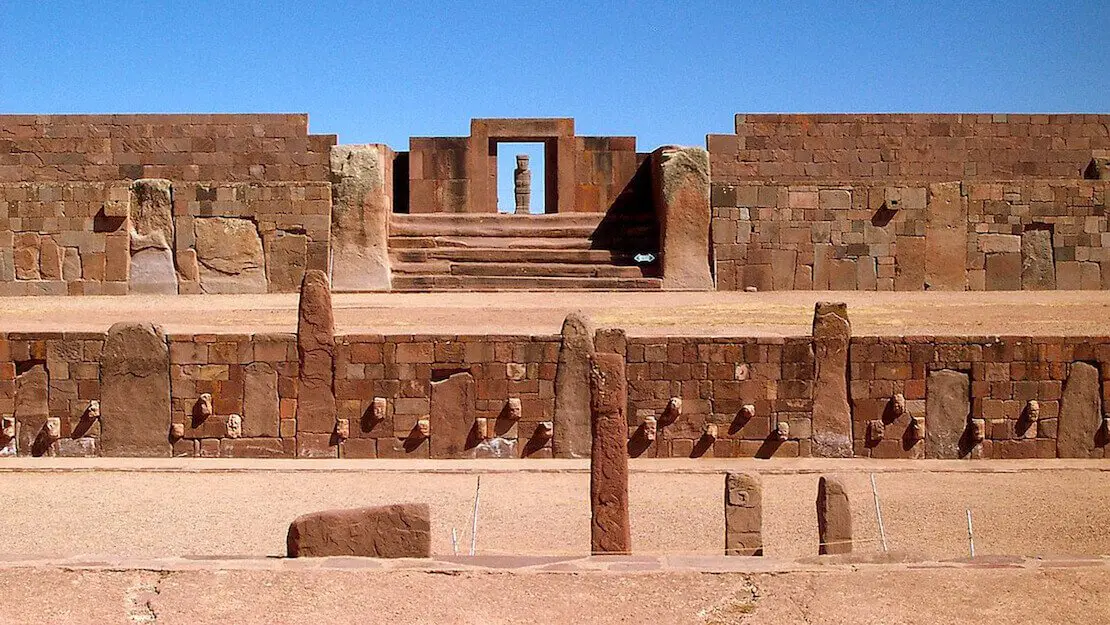
Tiwanaku.
Where to sleep in La Paz?
No Fear Hostel is nice and cheap, offers a hearty breakfast, and is within easy walking distance of the bus terminal.
Coroico
It is a small town that sits atop a hill at the end of Death Road. Here, the almost tropical climate is much more pleasant than in La Paz. It is a resort town where you can find many lodges surrounded by greenery, spas, etc. Many locals, especially from La Paz, come here to spend the weekend. It can also be used as an intermediate stop to break up the trip to and from Rurrenabaque.
What to do and see in Coroico
As mentioned above, the main activities here are relaxation and walking in the lush greenery that characterizes this area of Bolivia. Many hostels and lodges offer yoga sessions, pools, and massages. In short, it’s a small town to spend a few days relaxing surrounded by nature.
Where to sleep in Coroico?
Soy y Luna is a reasonably famous lodge. I slept in a cheap hostel downtown.
How to reach Coroico?
There are minibuses to La Paz that leave frequently starting from 3 am (priced at 20-25 Bs). If you plan to do the Death Road and visit Coroico, to save time and money, you could take your backpack with you on the morning of the tour and get dropped off at the foot of Coroico once the tour is over, instead of returning to La Paz.
A bus to Rurrenabaque departs around noon every day. The journey takes 15-20 hours, with the duration greatly affected by the season, and costs 100-120 Bs. It is strongly not recommended during the rainy season.

On a hike around Coroico.
Rurrenabaque
Also known as “Rurre,” it has grown in popularity recently, especially among backpackers, as it offers the cheapest tours to visit the Amazon rainforest. The main attractions here are Madidi Park and the famous pampas surrounding it.
What to do and see in Rurrenabaque
Visit the Amazon rainforest
Once you arrive in the village, you’ll find numerous local agencies ready to offer you any service you desire. I haven’t been to Rurrenabaque as I’ve been on a Amazon rainforest tour in Peru, but 900 Bs for a 3-day tour is a standard price. Admission to Madidi Park costs 125 Bs, while to the Pampas, it’s 150 Bs. To see more wildlife, it’s preferable to visit the Pampas.
You can check out this article.
How to reach Rurrenabaque?
Buses from La Paz cost about 100 Bs and take more than 20 hours. Some have described the trip as a real adventure. It should be avoided during the rainy season because the risk of getting stuck in the mud is high. In any case, it depends a lot on your time and budget.
The alternative is to take a flight with Amasznonas (Bs 500-600 for a one-way flight).
Copacabana
Copacabana is a small town on the Bolivian shores of Lake Titicaca, which, at 3,821 meters above sea level, is the highest navigable lake in the world. For many, this is a better base than Puno and Juliaca in Peru for exploring the lake, as the atmosphere is much more relaxed and pleasant. Interestingly, the famous beach in Rio de Janeiro is named after this village and not vice versa!

Isla del Sol.
What to do and see in Copacabana
Isla del Sol
You can take a boat from Copacabana to Isla del Sol, home to some sacred sites dating back to the Inca era and spectacular scenery.
Most people follow this one-day itinerary:
- At 8:00 am from Copacabana, departure by boat (30Bs round trip) and arrival in the northern part of the island around 10:00 am.
- Here, it is possible to explore some ruins and then walk to the southern part of the island (2-3 hours of walking, which I recommend if you are acclimatized) or return to the boat that heads to the south part around 1:30 p.m.
- The boat that leaves at 1:30 p.m., arrives at the south end of the island after about an hour, and leaves for Copacabana at around 4 p.m.
Food is much more expensive on the island than on the mainland, so I recommend bringing a packed lunch for those on a tight budget.
Warning: As of March 2017, visiting the northern and central parts of the island is no longer possible due to disagreements between the communities that control these territories. For this reason, many tours combine a visit to the southern part with the nearby Isla de la Luna.
June 2023 update from a blog reader: “You can visit the northern part and walk to the southern part, here, however, to return you have to pay for a new boat ride, with companies run by the southern community (the cost of one way is 30 bs).”
If you feel like it, you can actually do a full loop without having to take the boat back (All Trails).
From Copacabana, you can also take tours of the Uro Islands.
Cerro Calvario
Cerro Calvario (Google Maps) is the hill overlooking Copacabana. It’s a short walk from downtown Copacabana (about 30 minutes), although the climb is quite steep, and the altitude (almost 4,000 meters) can take its toll, so take your time ascending. Many people go up for the sunset, but I recommend going up for the sunrise. The sun setting over Lake Titicaca and the views of the village below are truly spectacular.
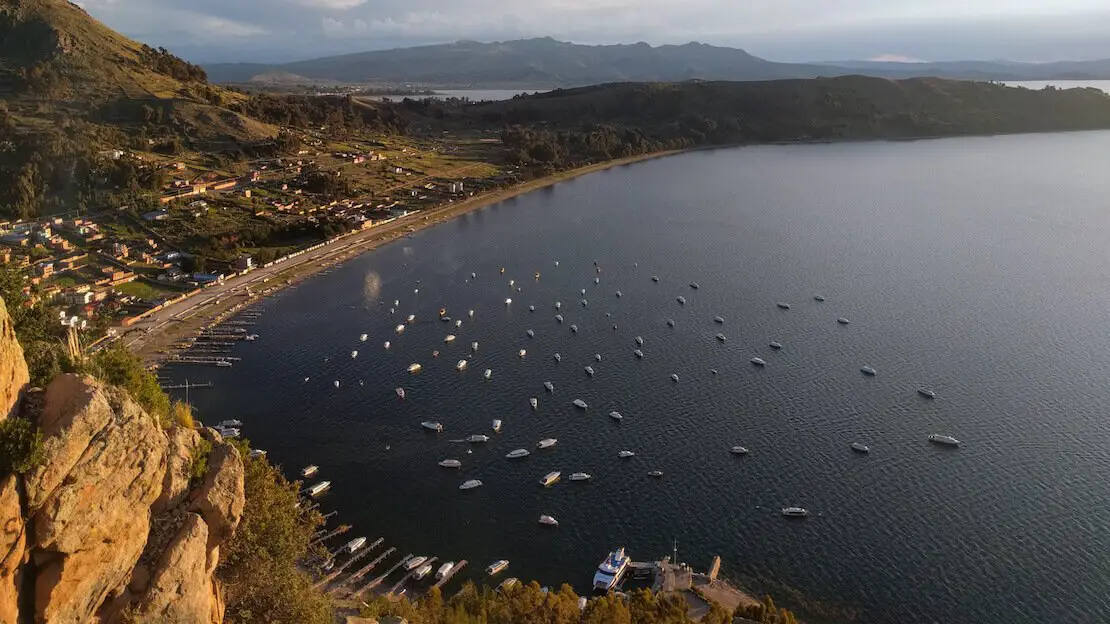
Cerro Calvario.
How to get to Copacabana?
To and from La Paz, buses leave regularly every hour and cost 15-20 Bs (bus prices are often negotiable). Additionally, a 2B fee for the boat will take you across a section of the lake while the bus rides on a raft. Buses to and from Puno in Peru cost about 35 Bs.
The Bus company Titicaca also offers a direct service to Cusco (you will only have to get off at the border); the cost is 100-120 Bs. There are three buses per day. I recommend the 6:30 p.m. night bus, which arrives in Cusco around 5 a.m.
Where to sleep in Copacabana?
There are many options right downtown where you can have a private room for 30-40 Bs. If you want to book online, check out Hostal Sol y Luna.
Oruro
Oruro is located 3700 meters above sea level and is the capital of the department of the same name, situated in the center of the great Bolivian plateau. The city is not a tourist destination for most of the year, but this changes during a very specific period: carnival! In fact, Oruro is home to what is considered one of the world’s largest and most beautiful carnivals.
So, if you are in Bolivia from February 4 to March 10, check the carnival dates and try to include Oruro in your itinerary.
How to reach Oruro?
Buses to and from La Paz leave frequently, about 3-4 hours, 15-20 Bs.
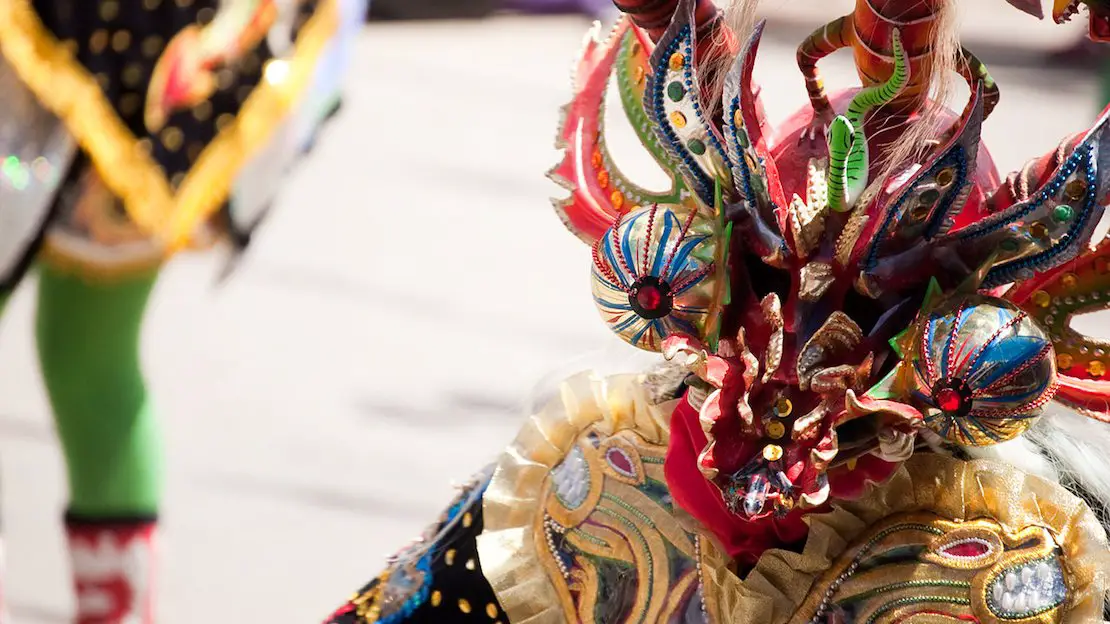
Oruro carnival.
Cochabamba
Also known as the City of Eternal Spring, Cochabamba is not exactly a tourist destination that attracts large numbers of travelers. It is more of an expat hub. The only major tourist attraction here is the Cristo de la Concordia, slightly larger than the Cristo in Rio de Janeiro, making it the second largest in the world. However, the city remains an excellent destination for anyone who wants to veer away from the classic tourist spots and immerse themselves in the local culture and community.
Cochabamba is also an ideal base for anyone who wants to explore Torotoro National Park, famous for dinosaur remains, rock formations and waterfalls. The park can be visited by arranging the tour directly in Cochabamba but for those on a budget it is advisable to reach the village inside the park by bus (5-7 hours) and arrange it from here, there are numerous hostels to spend the night, such as Hostal Wilma and Como en Casa. Entrance to the park costs 100 Bs and must be explored with a guide but fortunately there are tours that leave daily from the guides’ office in the main square and the cost is shared among all participants, which is ideal especially for those travelling alone.
A reader of the blog also recommends visiting Tarata, which can be reached from Cochabamba in just under an hour and on the same microbus that goes to Torotoro; Tarata is a very nice pueblito famous for the “comida”.Microbuses to Torotoro and Tarata leave at all hours from the intersection of avenida Republica and calle Valle Grande, price 35 Bs. In Torotoro the minimum price for a room with a shared bathroom is 40 Bs.
How to get to Cochabamba
By bus, it takes about 8 hours and 30 – 60 Bs to reach La Paz. It takes about 10 hours and 50 – 100 Bs to reach Santa Cruz, while it takes 8-9 hours and 30-50 Bs to reach Sucre.
Sucre
Sucre served as Bolivia’s capital for many years and remains its constitutional capital. Its rich history is reflected in the numerous well-preserved colonial buildings that populate the city, earning its historic center the distinction of being named a UNESCO World Heritage Site in 1991.
Situated at an altitude of 2800 meters, Sucre enjoys a pleasant spring-like climate year-round, reminiscent of Medellin in Colombia. This, coupled with the city’s beauty and the affordable cost of living, attracts many backpackers and digital nomads who often opt to stay for an extended period. Additionally, Sucre is a popular destination for those seeking affordable Spanish lessons.
What to do and see in Sucre
The city and its surroundings offer a plethora of attractions and activities, making it a popular destination for visitors to the country. From paragliding launches to horseback riding, there is no shortage of things to do. Below, I’ve listed some activities that can be enjoyed independently and inexpensively:
Explore the city
As mentioned, the streets near the center are excellent and photogenic, so take a stroll around Plaza 25 de Mayo (Google Maps) to experience the city’s atmosphere. I also recommend visiting Mercado Central (Google Maps), where you can find inexpensive local food on the second floor for lunch.
Head to la Recoleta (Google Maps), the main square in front of the church, where there are often events and an excellent view of the city. The “Mirador Cafe” is reasonably priced and offers an incredible view.
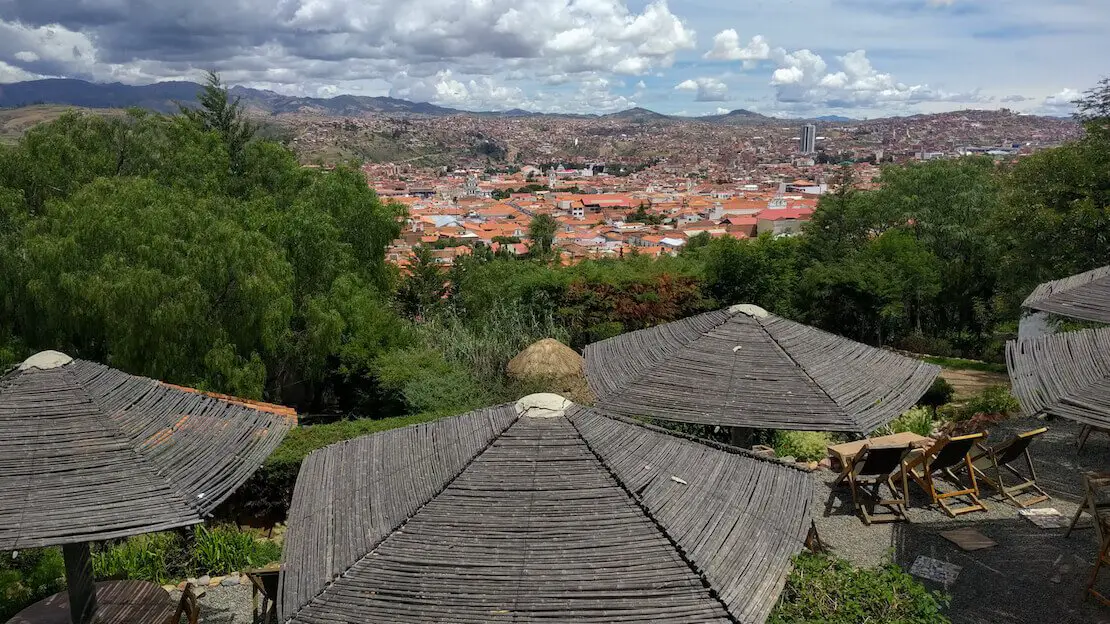
Mirador Cafe.
7 cascadas
The falls are certainly not spectacular, and during the dry season, there is very little water flowing, so it is best to visit from November to April. However, the setting is beautiful. I hope the area has been cleared of trash, and it is still an excellent way to spend a day with friends. All agencies in Sucre offer the tour, but it is easy to do on your own.
How to reach the seven cascades?
Take a “Q” line minibus from Calle Junin outside the Central Market and get off at Alegria (the last stop). The cost is 1.50Bs, while by cab, it is about 20Bs. Once you get off the bus, keep walking in the same direction. Once you pass the houses, turn right, going down the hill until you reach the river, then follow it upstream for about 45 minutes (there is a need to climb the rocks in some sections), or take the path on the left just after the bridge. The whole thing is straightforward, but you can always download organicmaps for more certainty about which direction to follow.
Maragua Crater
This is a two-day trek, which I strongly recommend, through surreal landscapes, small rural communities, and even dinosaur footprints. It is possible to do this with a tour, but doing the following is relatively easy on your own. First, download organicmaps to your phone (you will almost certainly need it). Take the 9:30 am bus (10Bs) from “Parada a Ravelo” to Potolo and ask to get off at “Capilla de Chataquila.”
Shortly after, on the left is a well-marked and maintained Inca trail that follows downhill to the bottom of the valley (you have to pay 10Bs to the community once you reach the end of the trail). You often walk along the road from here, and I recommend relying on maps until you reach the small village of Maragua (Marawa) in the middle of the giant crater. I was with a friend, and we slept in really nice huts for 65Bs each, with dinner and breakfast included.
The next day, go up the crater and follow the road past the villages of Ninu Mayu and Chulpa (I suggest you set your GPS for “dinosaur footprints”). Theoretically, you have to pay 20Bs, but when we arrived, there was no one there. From here on, we walked relying on the GPS for at least half an hour before we got to a dirt road that led us to Potolo (the road/trail was either not there, or we didn’t see it; set the GPS for Potolo).
From Potolo to Sucre, buses leave frequently during the day but try not to arrive too late in the afternoon to avoid spending the night in Potolo. If, for whatever reason, you don’t want to do the trek alone, then I recommend Condor Trekkers. This is an NGO that operates in Sucre and invests its profits in local culture and ecology.
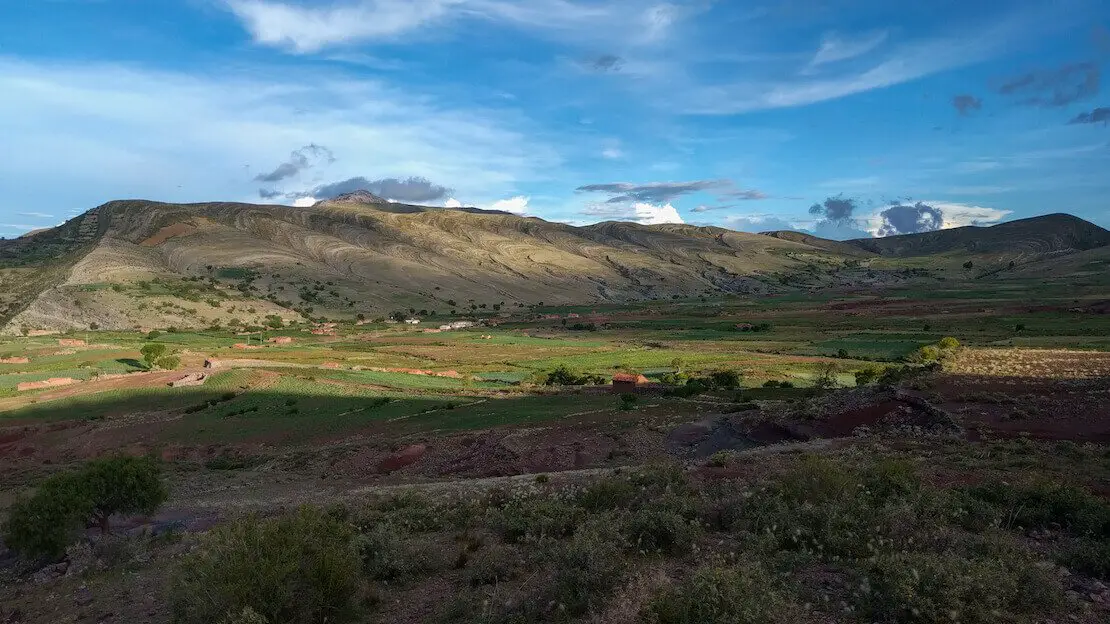
Managua Crater.
Where to sleep in Sucre?
Dragonfly Guest House is really cheap and clean. I have also been to Kultur Berlin. The hostel is nice but does not have a family atmosphere, and the bar inside could be cheaper.
How to reach Sucre?
Sucre is well connected, you can get direct buses to and from all the major cities nearby: La Paz, Oruro, Potosí, Santa Cruz, Cochabamba and Tarija.
Santa Cruz
Santa Cruz is located at a low altitude near the Amazon rainforest and serves as an excellent base for exploring the forest and nearby national parks. The city has a distinct atmosphere compared to the rest of Bolivia; it’s considered the country’s wealthiest and most prosperous city, boasting one of the highest growth rates globally. It’s notably more modern than other cities, and its inhabitants are often viewed as snobbish by the rest of Bolivia!
What to do and see in Santa Cruz
I haven’t personally visited the city, as it doesn’t offer much besides what seems to be a vibrant nightlife. As mentioned earlier, many travelers use it primarily as a base for exploring nearby national parks, such as Amboro National Park, which is just two hours from Santa Cruz. The park is estimated to be only 50 percent explored and holds the world record for the number of bird species sighted.
However, if you’re interested in visiting this incredible national park without using Santa Cruz as your base, I recommend doing so from Samaipata, a small mountain village about two hours by bus from Santa Cruz when coming from Sucre. Samaipata is popular with backpackers and offers a more relaxed atmosphere and better weather. Besides visiting Amboro Park, there are other exciting activities; I recommend you check out this article.
How to reach Santa Cruz?
If you decide to visit Santa Cruz, it’s advisable to do so from Sucre. By bus, the journey takes about 12 hours, and you can expect to pay around 100 Bs for a decent bus. To reach Samaipata, you can take the same bus, which takes approximately 9-10 hours.
Where to sleep in Santa Cruz?
Nomad Hostel is a popular choice.
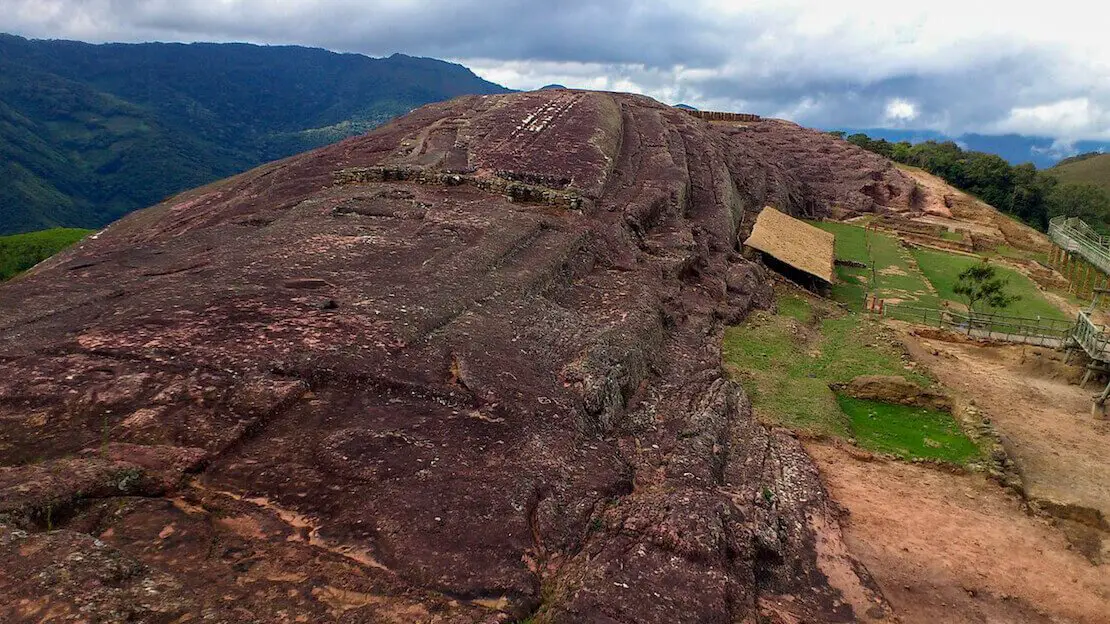
Samaipata fort.
Potosi
The city is renowned for the nearby Cerro Rico mountain, home to some of the world’s richest silver mines. Over the centuries, the hill has been extensively mined, and to this day, approximately 10,000 people toil within its tunnels under harsh and inhumane conditions.
While tours of the mines are the primary reason for visiting the town, I chose to avoid them after reading extensively about the poor working conditions endured by the miners. However, such tours might offer a direct insight into the societal costs associated with extracting precious metals. A mine tour typically costs around 100 Bs. If you want information on what to do in Potosi besides visiting the mines, check out this article.
One blog reader recommended a visit to the Casa de la Moneda, where they tell you about the development and subsequent collapse of the Bolivian economy (since 1956 they have not printed their own currency in the country but imported it!).

Potosi miners.
Tarija
It is a small town in southern Bolivia near the border with Argentina. It is located in the middle of the wine country, has a great climate and the relaxed atmosphere of a small town.
What to do and see in Tarija
The city and its surroundings lack phenomenal attractions, but as mentioned, the center is pleasant and quite livable. I was fortunate to visit during the carnival, where people filled the streets armed with water balloons, creating a lively and festive atmosphere.
Some popular excursions in the area are the tour of regional wineries that cost about Bs 100 and trekking in the valley of the Condors.
How to reach Tarija?
From Sucre, It takes about 10 hours, Only two companies operate the route. After negotiation, I managed to lower the initial price from 120 Bs to 70 Bs (as is often the case in Bolivia). From Tupiza, it costs about 50 Bs and takes 7 hours to travel. The road offers stunning scenery, and I highly recommend traveling during the day if possible.
Where to sleep in Tarija?
Casa Blanca Hostel is a good option close to the city centre.
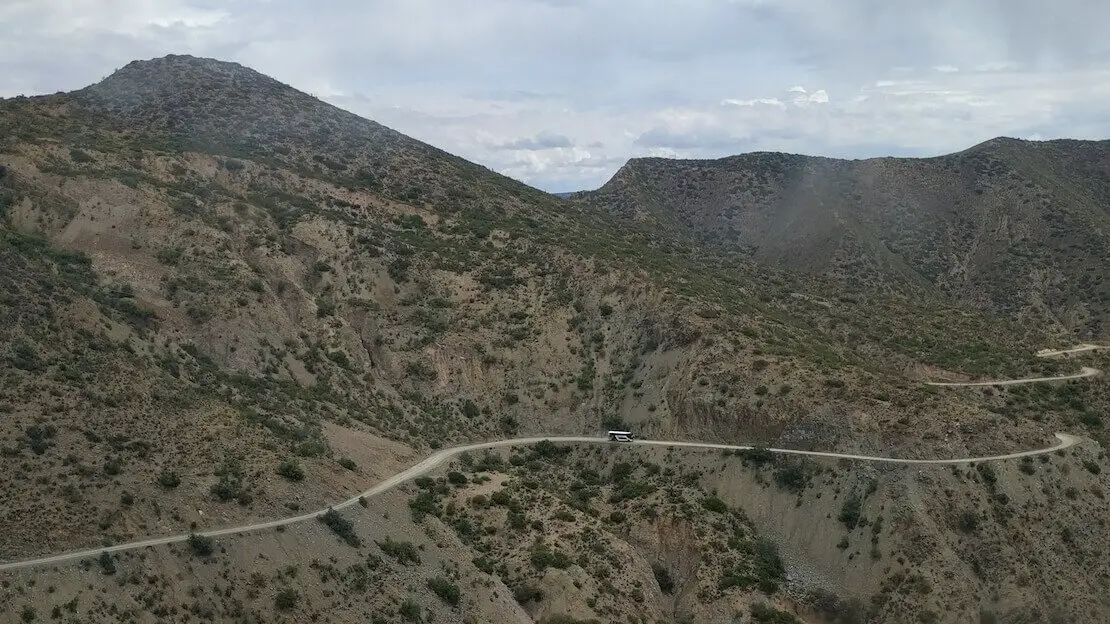
Road from Tarija to Tupiza.
Tupiza
Tupiza is another small town situated on the border with Argentina, often serving as a stopover for travelers before departing Bolivia or upon arrival from Argentina. Many visitors also come to Tupiza to embark on an extended version of the classic Salt Desert tour.
What to do and see in Tupiza
The town itself is quite small and not particularly picturesque, but its surrounding area boasts valleys, canyons, and intriguing rock formations that are perfect for exploration on foot or horseback.
Puerta del Diablo
It is a rock formation not far from town. This should be the main attraction, but the whole valley is photogenic and worth visiting (Google Maps). Reaching it on foot is easy by following my directions, but to be on the safe side, as always, I recommend downloading organicmaps.
From the city center, head south along the old tracks leading out of town for about 10 to 15 minutes until you reach a large building on the right, which serves as a gym/pool; turn right there. Follow the dirt road, being mindful of horse poop, toward the rock formations visible in the distance on the left. Once you enter the valley, you’ll encounter signs indicating the names of the main rock formations. The path through the valley is straightforward until you reach the end, where the Inca Canyon begins. The entire journey should take no more than 3 hours, but remember to bring plenty of water as it can get quite hot.

Inca canyon.
Salar de Uyuni from Tupiza
There’s an option to embark on the famous Salt Desert tour starting from Tupiza instead of Uyuni. This 4-day tour, unlike the 3-day “classic tour,” explores less-traveled areas and visits iconic places at different times. If you’re seeking the most budget-friendly option, I suggest taking a bus to Uyuni and joining a tour from there. However, if budget isn’t a concern, this alternative offers a less “mainstream” experience.
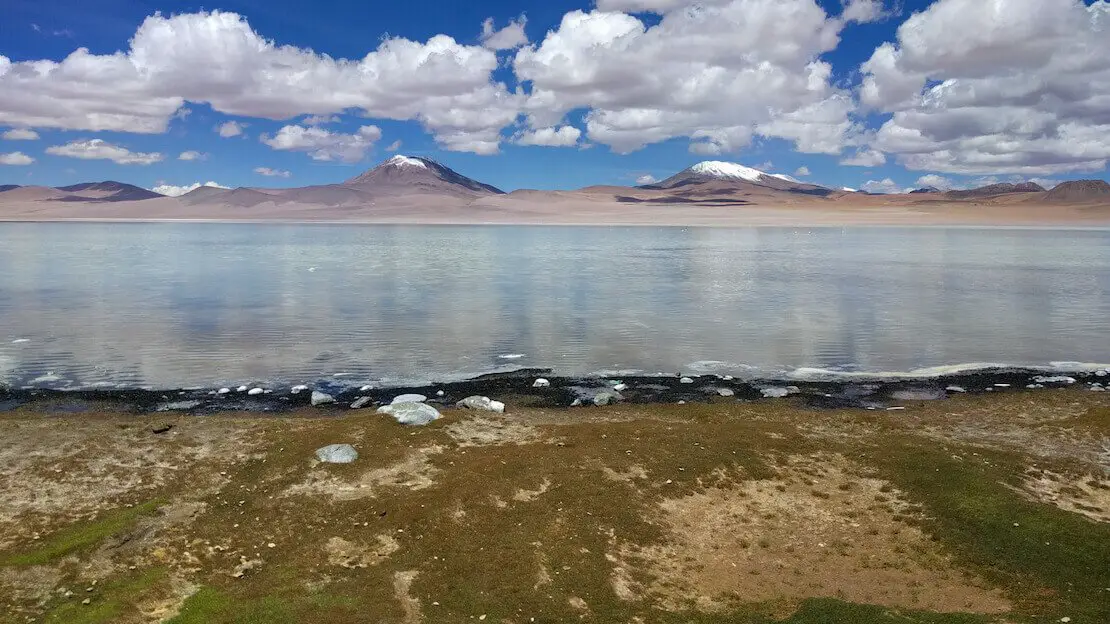
The surreal landscapes visited during the jeep tour.
How to get to Tupiza?
From Villazon (border with Argentina), it is 15Bs, 1-2 hours.
From Potosi, it is 6-7 hours and 40-50Bs.
From Uyuni it is 5-6 hours, 50Bs.
From Tupiza, it is about 50 Bs and 7 hours of travel time.
Where to sleep in Tupiza?
There are many hostels not listed on the various booking sites. Walking downtown from the station and finding a dorm bed for 30-40 Bs will not be difficult. If you want to book online, check out Hostal Aramayo.
Uyuni
It’s a small town in the middle of nowhere that originated as a trading outpost and crossing point for Bolivia’s initial railroad network. Today, it’s the most tourist-oriented Bolivian town, largely due to the world’s largest salt desert from which it derives its name.
The Salt Desert (salar de Uyuni)
The Salt Desert is the remnants of vast prehistoric lakes that have dried up. The landscape is incredible and striking; no one on a trip to Bolivia should consider this an optional destination.
It can be visited in a day from Uyuni, but if your budget allows, I strongly recommend joining the classic 3-day tour. This tour, in addition to the salt desert, will take you to see other truly incredible sites: colorful lagoons filled with flamingos, geysers, snow-capped volcanoes, hot springs, curious rock formations, and much more, reaching as far as the Chilean border. If you wish, you can continue to San Pedro de Atacama or stay aboard the jeep and return to Uyuni.
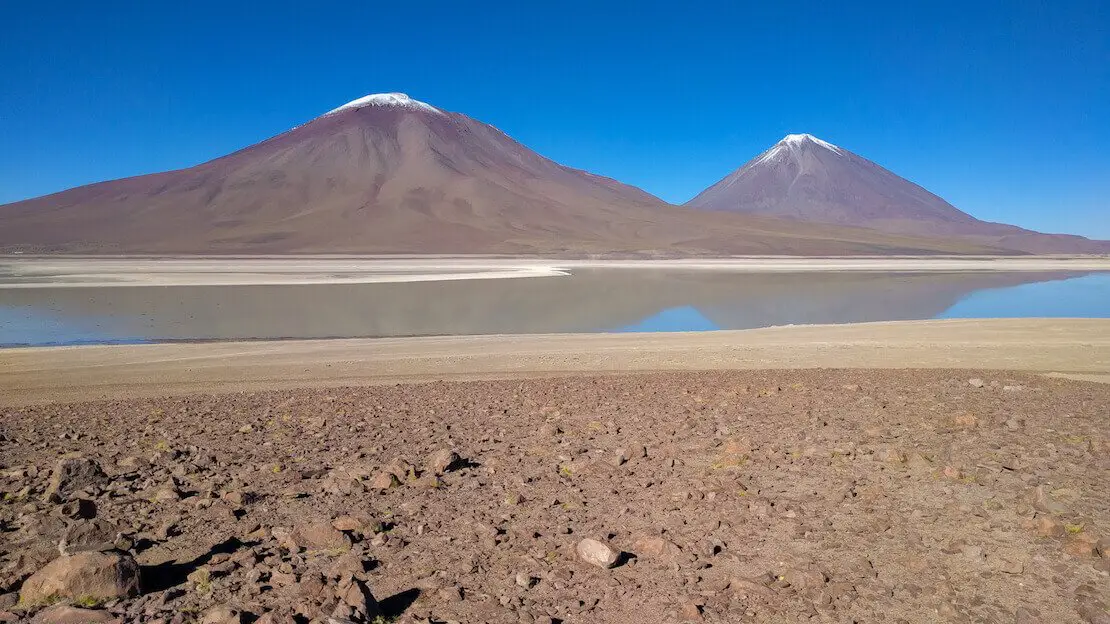
Laguna Verde.
The itinerary from the various agencies is pretty much standard, and you travel in large 7-seater jeeps, sleeping in basic accommodations along the way. Everything is included in the price, including transportation from the border to San Pedro de Atacama in Chile if needed. Despite hearing some unpleasant stories, I have to say that our driver was professional and friendly.
One agency is as good as another, so shop around Uyuni and choose the cheapest one. I paid Bs 600 in March 2017, but I heard you can pay as low as 500. To this price, Bs 150 must be added for the entrance to the Reserva Natural de Fauna Andina Eduardo Avaroa.
If you want to read about the 3-day tour in detail, I suggest you check out this article.
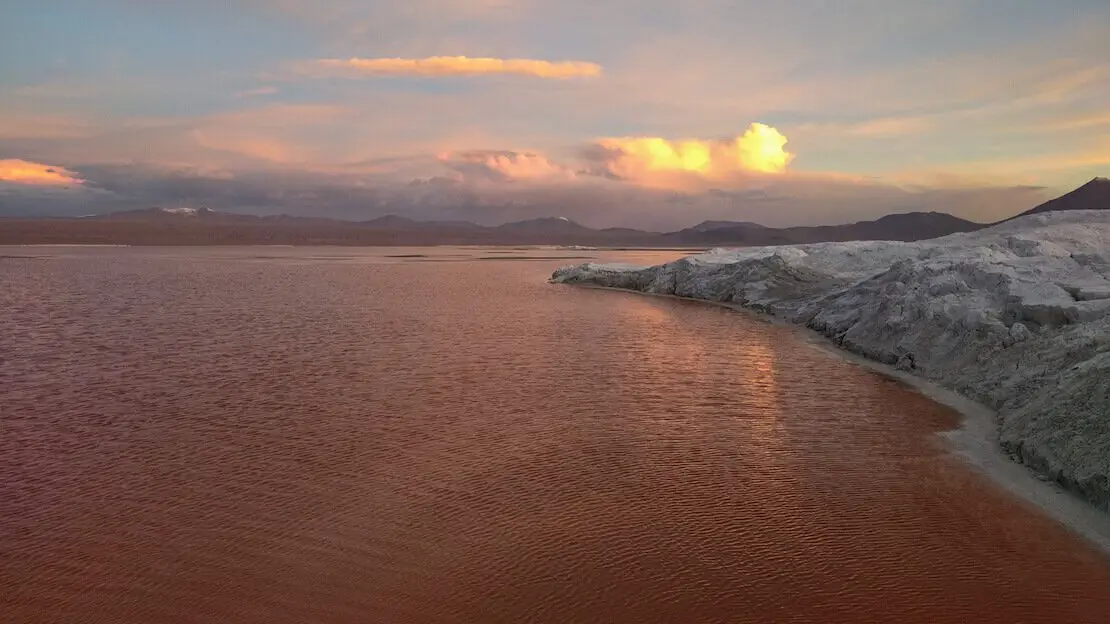
Laguna colorada, Riserva Eduardo Avaroa.
Small parenthesis for those heading to Chile: Try to exchange your Bolivianos in Uyuni—the exchange rate is great, and there are 2-3 exchange houses along the main road. But make sure you have with you the 150 Bs to pay the entrance fee to the reserve and at least another 10 Bs to cover the exit tax at the Chilean border (there are no ATMs in the desert). Officially, the tax doesn’t exist, but being in the middle of nowhere, you have no choice (corrupt immigration). Some friends, knowing this, had their passports stamped in Uyuni. I exchanged the few bolivianos I had left at the border with other travelers about to embark on the tour in the opposite direction.
For those on a really tight budget who only want to see the salt desert, it’s possible to take any bus to Oruro, get off at Colchani, and then walk in the direction of the salt desert, which is not far away.
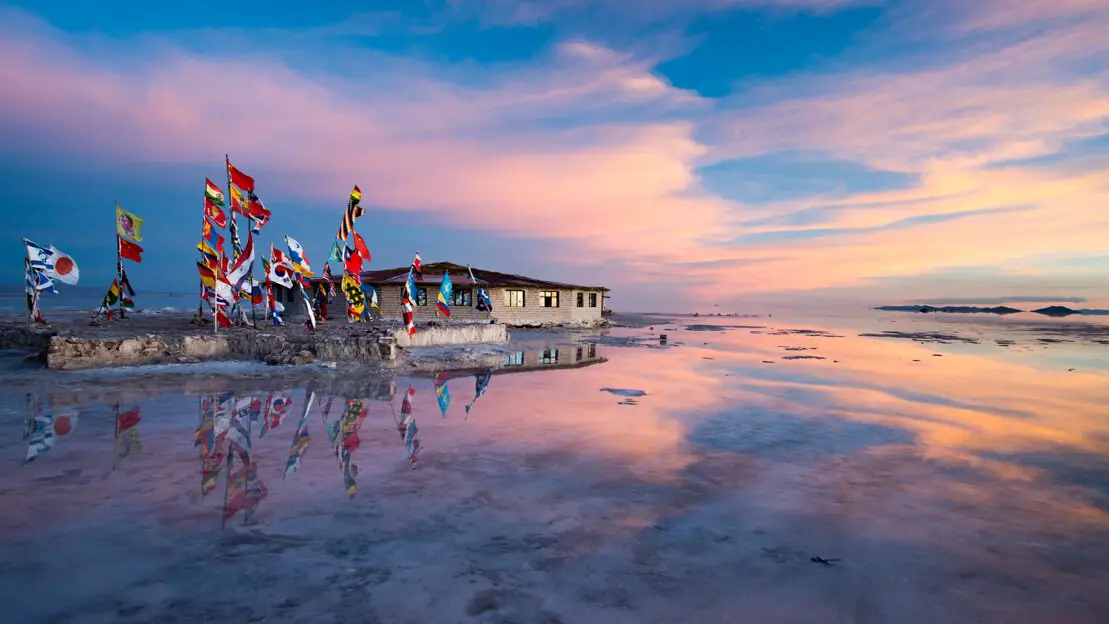
Salt flats at sunset.
Salt flats: when to go?
The best time is probably just after the rainy season is over between April and May when rainfall is low but you can still enjoy the famous “mirror” effect you see in the picture.
How to reach Uyuni?
From Sucre, it is about 80 Bs and 7-8 hours of travel time. From Potosì, it is about 4 hours, 30 Bs, while from Tupiza, it is about 50 Bs and 7 hours of travel time.
Where to sleep in Uyuni?
There aren’t any particularly standout hostels that I can recommend, but there are plenty of budget-friendly options where you can spend the night. Unfortunately, I don’t recall the name of the place where I stayed. If you want to book online, check out Piedra Blanca Backpackers Hostel.
If you found this article helpful, please consider purchasing your travel insurance through one of the links on this site, doing so supports my work at no additional cost to you. For EU & UK Residents, i recommend True Traveller. For everyone else i recommend HeyMondo (5% discount). Thanks!
Suggested itineraries Bolivia
Below, I present possible 2-week, 3-week, and 4-week itineraries. Understandably, there’s no perfect itinerary given a set time frame, so consider this as inspiration and adapt the plan based on your interests and budget, taking into account what you’ve learned so far!
2-week itinerary in Bolivia
This itinerary is tailored for a two-week journey through Bolivia, aiming to strike a balance between exploration and relaxation while keeping travel costs in check.
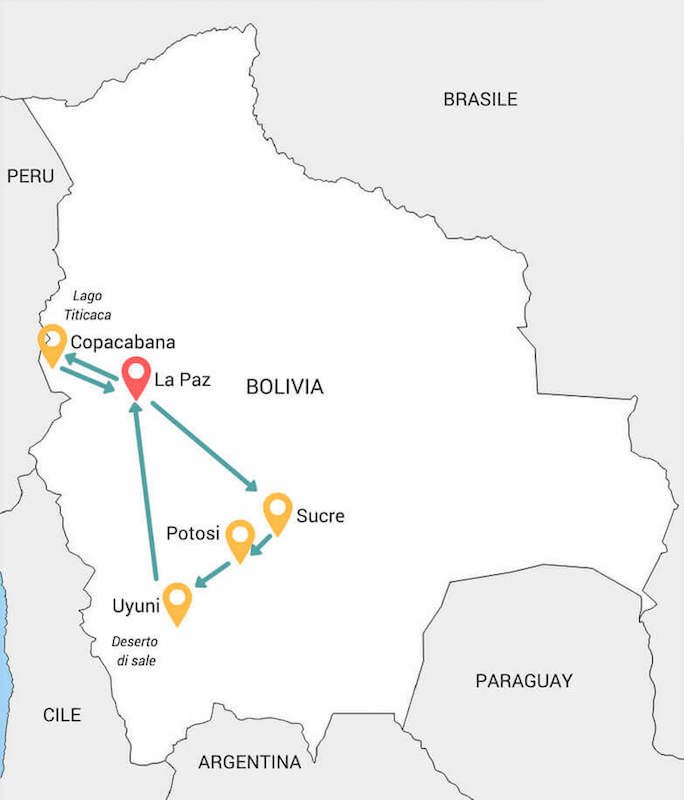
La Paz (3 nights)
Day 1:
If you arrive in La Paz from sea level, you will likely need at least a few days to acclimate.
Day 2:
You can choose some activities: a free walking tour, a cable car ride to El Alto, Cholita wrestling, or a visit to the Valley of the Moon.
Day 3:
Do the death road.
Copacabana (2 nights)
Day 4:
Leave early in the morning from La Paz, book the tour to Isla del Sol for the next day, and go up to Cerro Calvario to see the sunset.
Day 5:
Tours to isla del Sol and la Luna.
Sucre(2 nights)
Day 6:
Return to La Paz and catch an overnight bus to Sucre, departing between 6:30 and 8:00 p.m. If you arrive early, you can store your luggage at the bus terminal (located just inside on the left), explore La Paz for a couple of hours, and then board the bus.
Day 7:
Explore Sucre.
Day 8:
You would like to do seven cascades or any other activity/tour in and around Sucre.
Potosi (2 nights)
Day 9:
Bus from Sucre to Potosi in the morning. Explore the city and book a mine tour for the following day.
Day 10:
Take a mine tour in the morning and transfer to Uyuni in the early afternoon. Upon arrival in Uyuni, book the tour for the following day.
Uyuni ( 3 nights)
Day 11:
Salar de Uyuni. (first-day 3-day tour described above).
Day 12:
Eduardo Avaroa Reserve (second day 3-day tour described above).
Day 13:
3-day tour described above. Return to Uyuni by overnight bus to La Paz.
Day 14:
Arrival in La Paz. Return home.
3-week itinerary in Bolivia
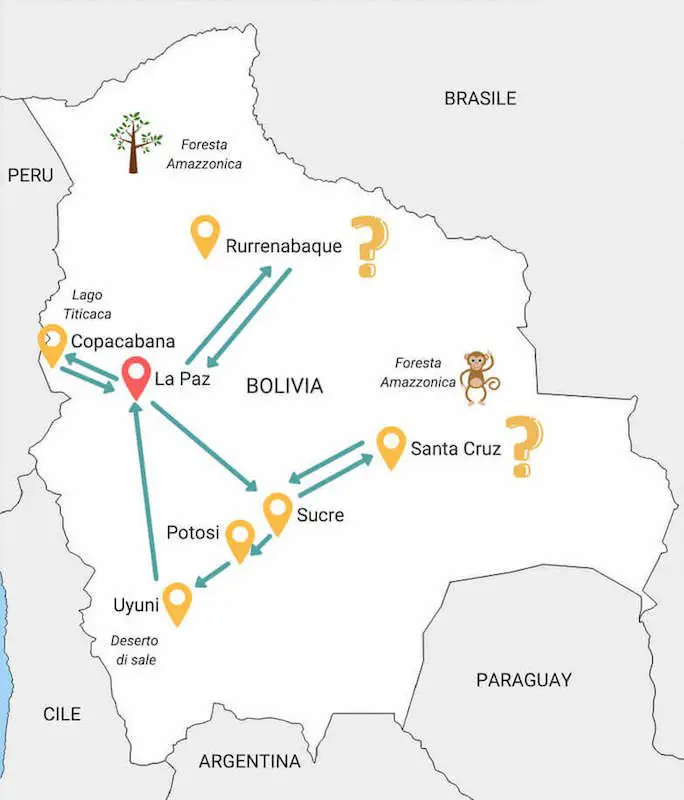
3-week itinerary in Bolivia
In addition to the itinerary outlined above, with an extra week to spare, I would personally consider visiting the Amazon rainforest in Rurrenabaque or Santa Cruz. I’d also extend my stay in Sucre to explore more of this charming city and perhaps do the trek to the Maragua crater. Additionally, I’d consider spending a few days relaxing in Coroico and, for those interested, attempting the ascent of Huayna Potosi. If attempted after more than two weeks at high altitude and therefore fully acclimatized, it should be achievable for many and undoubtedly an incredible experience.
4-week itinerary in Bolivia
With four weeks to spare, you have the flexibility to visit virtually all the major tourist destinations described above at a more relaxed pace. You can follow the 3-week itinerary with more leisurely stops and exploration. Alternatively, you can venture beyond Bolivia’s borders to explore neighboring attractions.
Visiting San Pedro de Atacama in Chile (at the end of the 3-day tour from Uyuni), hopping to Argentina via Tupiza, or taking a short trip to southern Peru from Copacabana are all viable options that complement the Bolivian itinerary. Ultimately, your choices depend on your interests and preferred style of travel.
How to get around Bolivia
Buses in Bolivia
Buses in Bolivia offer the most cost-effective way to travel, with a highly efficient network connecting major cities and frequent departures. For long distances, there are different types of buses available. “Cama” buses are the most comfortable, featuring only three rows of seats instead of four, providing ample space and reclining seats up to 160 degrees.
Some reputable companies known for their quality service include El Dorado, Trans Copacabana, Bolivar, and Todo Turismo, albeit at a higher price point. When choosing a bus company, I usually compared prices among different operators at the station and opted for the most affordable option, aiming for at least a semi-cama seat, especially for longer journeys. While I’ve never had a bad experience, if you prefer modern buses, it’s advisable to consider the aforementioned companies.
Another top-rated company that works almost exclusively with tourists is Bolivia Hop. It allows you to pay for a pass that will enable you to move whenever you want within a given itinerary with “pick up” at your hostel/hotel. This company also operates in Peru under the name Peru Hop, allowing you to buy valid passes for both countries. Of course, while convenient and efficient, the service offered is much more expensive than local buses.
You can visit the Tickets Bolivia website to compare prices from major Bolivian bus companies or simply check departure times. However, for the best rates, I recommend purchasing your ticket directly at the terminal. Additionally, be aware that a transit fee of 2Bs is often charged at bus stations.

Local bus on the left, micros/collectivos on the right.
Taxi in Bolivia
As always in South America, exercise caution when taking a cab. Ask your hotel or hostel for the correct price for a specific route, and be sure to agree on a fare before getting into the cab. Radio cabs are the most reliable option since they are operated by legal companies; they typically display a phone number on the roof for you to call. Additionally, applications such as Uber and Easy Cab work in certain cities.
Flights in Bolivia
Domestic flights are not particularly expensive, although buses remain far cheaper. They are an option for those with time rather than budget concerns. Companies that operate internal flights are Boa and Gol.
Hitchhiking in Bolivia
Hitchhiking in Bolivia is not a common practice, at least not in the conventional sense. Most drivers expect payment after offering you a ride, so it’s essential to clarify upfront if you’re not willing to pay or agree on a price beforehand to avoid any misunderstandings.
Backpacking Bolivia: costs
How much does a trip to Bolivia cost?
Transport
Getting around by bus is extremely affordable in Bolivia, with fares typically ranging between 5 and 10 bolivianos per hour of travel. Purchasing tickets directly at the time of departure can often lead to better deals, as many companies are willing to lower prices to fill up the bus. This is particularly common at larger stations where multiple companies operate concurrently, with ticket sellers calling out destinations similar to vendors at a market. Haggling is straightforward, given the competition among companies departing at the same time.
For instance, I managed to secure a cama seat on the second floor of a bus from La Paz to Sucre for just 100 Bs after negotiating for a while. Interestingly, I encountered two German travelers who had paid 120 Bs for a semi-cama seat on the same bus!
Accommodation
Accommodation is also extremely cheap. A dormitory bed normally costs between 30 and 60 Bolivianos, although the price varies greatly depending on the city and time of year.
Food
Bolivian cuisine may not be considered among the finest in South America, but it is known for its hearty and affordable options. The menu del diá, commonly available for lunch at local markets and restaurants, typically costs between 10 and 15 Bolivianos and includes an appetizer or soup, a main course, and a drink.
For those who prefer to cook, I suggest purchasing fruits and vegetables at the market, where prices are usually much lower than in supermarkets.
Activities
The only “expensive” activities to participate in Bolivia are the 3-day tour from Uyuni to San Pedro, which, however, for about 100€ all-inclusive, is certainly not a bad deal, and a possible tour of the Amazon rainforest in one of the famous parks. All other day trips can often be done independently.
In conclusion, Bolivia is a highly inexpensive country that lends itself perfectly to a low-cost backpacking trip. Those who are budget-conscious can easily travel around €25 per day.
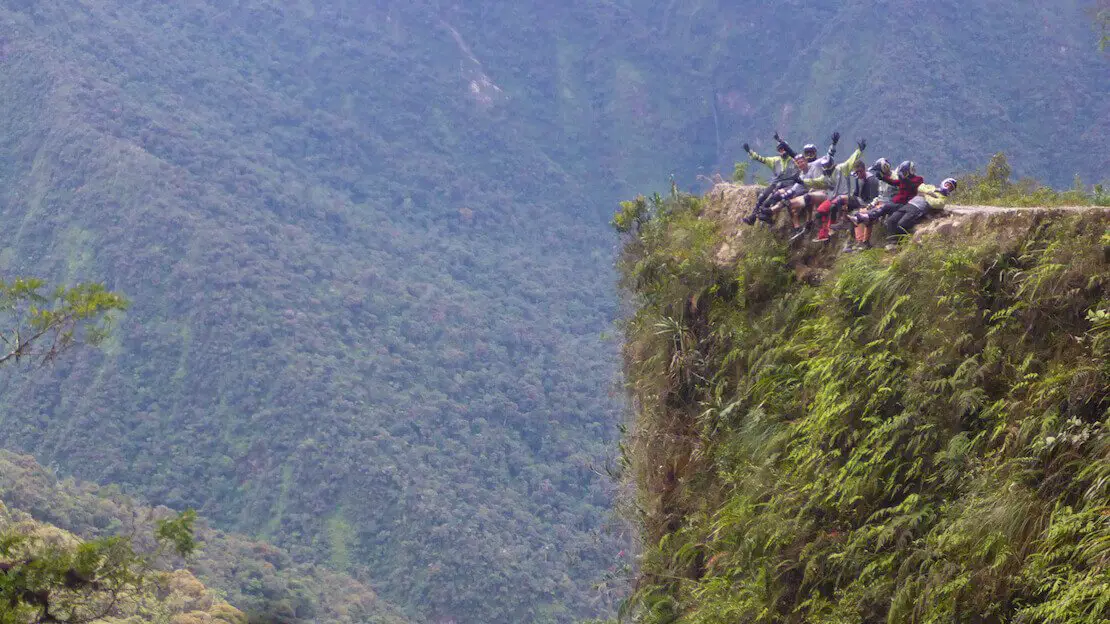
Camino de la Muerte.
Backpacking Bolivia: safety
Is Bolivia dangerous?
No, or at least no more than in other South American countries. As in any other country in the world, it is often simply a matter of common sense. Some cities and neighborhoods are definitely to be avoided, especially at night. Having said that, during my stay in Bolivia, I never felt threatened, and although the locals may give the feeling of being unwelcoming, they are still kind and helpful people in their own way.
However, these are rare and easily avoidable occurrences. In any case, I recommend you read my tricks for traveling safely.
Are you planning a trip to Bolivia? Check out these posts:
Do you have any questions? Updated information? Feel free to leave a comment or message me on Instagram!
If you found this article helpful, please consider purchasing your travel insurance through one of the links on this site, doing so supports my work at no additional cost to you. For EU & UK Residents, i recommend True Traveller. For everyone else i recommend HeyMondo (5% discount). Thanks!
For donations/pizzas and virtual beers 🙂
Did you like the post? Pin it!
